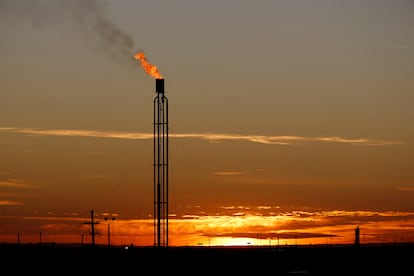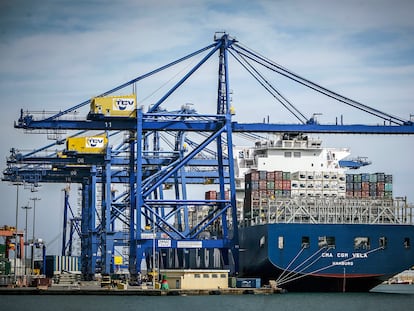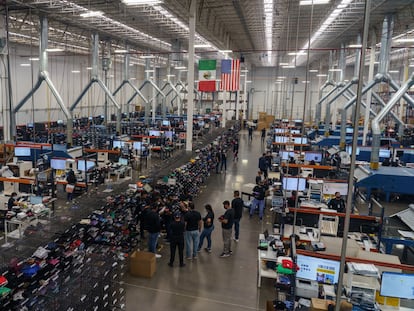The US uses cheap gas to win the industrial battle
The low cost of energy in the country is a great asset when it comes to attracting manufacturing interest. Germany no longer has Russia’s pipeline, which makes industrial activity more expensive

With gas from Texas, Pennsylvania, and Louisiana, the United States not only has a powerful money-making machine: it also has a tool to convince emerging industries to settle in the country. Its vast underground reserves and the powerful fracking revolution have turned the North American giant into the world’s largest producer and exporter of gas, which is essential in heat-intensive manufacturing processes. And this is leading dozens of big names in the secondary sector — especially in high-skilled and technology-intensive sectors — to knock on the country’s door.
These days, the best industrial policy is cheap energy. In Germany, disconnected by force majeure from Russian gas — which arrived via a pipeline at knockdown prices — industry has been left without one of its greatest competitive advantages. Without cheap gas, its secondary sector has taken a hard hit. With new trump cards on the table, American gas is presenting its best selling points: it is protected from the vagaries of geopolitics, boasting its own abundant and, above all, very competitive resource. After falling by half in the last month, American gas is currently nearing historical lows and is four times cheaper than gas in Europe. And that’s behind big industry’s interest in setting up shop in the United States.
After Russia invaded Ukraine, the European Union — America’s partner in defense and security but a rival in the race to attract cutting-edge industries — has been forced to replace the Russian gas from pipelines with liquefied natural gas (LNG), which travels by ship. This switch was anything but simple, requiring new regasification terminals, with eight built in under two years. What’s more, LNG — which the U.S. sends in by the ton — is by definition much more expensive than Russian gas. This has hurt the bottom line of the EU’s top manufacturing countries, a list headed by Germany, Italy and Eastern European nations.
Projects underway
The U.S. industrial sector’s investment in new production plants — or in renovating existing ones — doubled between mid-2022 and mid-2023, reaching a new all-time high, according to data compiled by Bloomberg. Most of this investment came from the semiconductor sector, which has been buoyed by the integration of artificial intelligence. But interest wasn’t just coming from chip manufacturers: despite the higher labor costs in the United States, legions of companies — especially in high-value-added sectors — have set up shop.
The country’s present is marked by the fact that it has its own cheap source of gas. But the Biden administration is aware that the future of industry depends on renewable energy. With this in mind, it passed the Inflation Reduction Act (IRA), which provides incentives to invest in wind and solar energy and energy storage. In contrast to the rhetoric of the Trump era — based on tariffs and threats to companies planning to move offshore — Biden sees these technologies, by far the cheapest for generating electricity, as the best bet to ensure that the industrial boom continues.
Mexico, another beneficiary
The impact of America’s cheap gas extends far beyond the country’s borders. Its southern neighbor, Mexico, has also benefitted. For decades, it has been a priority destination for lower value-added manufacturing investment, and it is also taking advantage of two key trends in the new global dynamics of industry: reshoring (companies that return to produce in their country of origin) and friendshoring (companies that set up in a country that has good relations with their place of origin).
With industry looking to relocate to nations that are friendlier and closer to the world’s main consumers, Mexico has the best possible credentials: thousands of miles of border with the U.S.; excellent access to the largest market on the planet; qualified personnel; a well-slicked supply chain and cheap gas. That’s one of the benefits of having a direct connection, through half a dozen gas pipelines, to the world’s new energy king.
Sign up for our weekly newsletter to get more English-language news coverage from EL PAÍS USA Edition
Tu suscripción se está usando en otro dispositivo
¿Quieres añadir otro usuario a tu suscripción?
Si continúas leyendo en este dispositivo, no se podrá leer en el otro.
FlechaTu suscripción se está usando en otro dispositivo y solo puedes acceder a EL PAÍS desde un dispositivo a la vez.
Si quieres compartir tu cuenta, cambia tu suscripción a la modalidad Premium, así podrás añadir otro usuario. Cada uno accederá con su propia cuenta de email, lo que os permitirá personalizar vuestra experiencia en EL PAÍS.
¿Tienes una suscripción de empresa? Accede aquí para contratar más cuentas.
En el caso de no saber quién está usando tu cuenta, te recomendamos cambiar tu contraseña aquí.
Si decides continuar compartiendo tu cuenta, este mensaje se mostrará en tu dispositivo y en el de la otra persona que está usando tu cuenta de forma indefinida, afectando a tu experiencia de lectura. Puedes consultar aquí los términos y condiciones de la suscripción digital.
More information
Archived In
Últimas noticias
Most viewed
- Alain Aspect, Nobel laureate in physics: ‘Einstein was so smart that he would have had to recognize quantum entanglement’
- David King, chemist: ‘There are scientists studying how to cool the planet; nobody should stop these experiments from happening’
- Maps of the US attack on Venezuela: Targets, airspace and deployed fleet
- Key points of the military attack on Venezuela: Early morning bombings and a ‘captured’ president
- World reactions to the US strikes on Venezuela











































